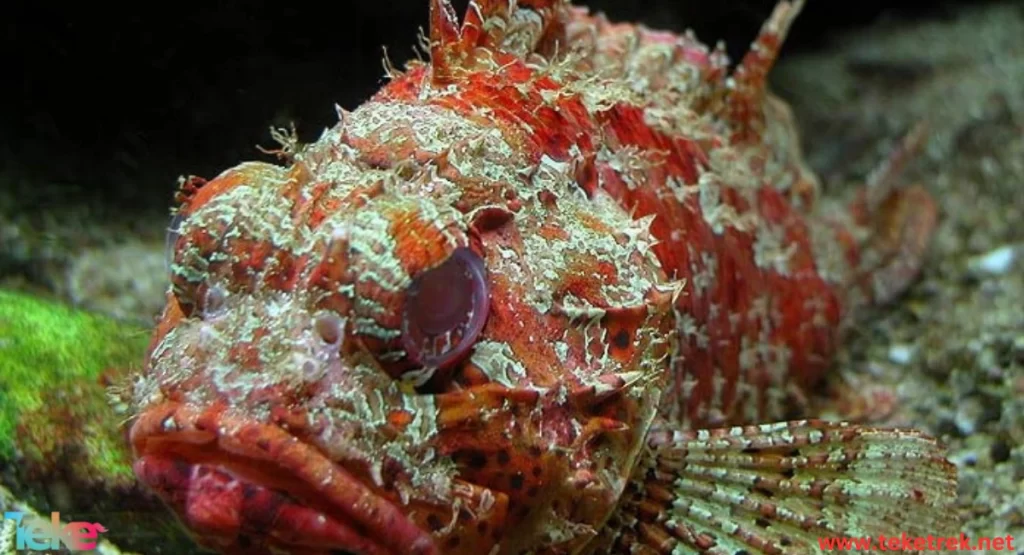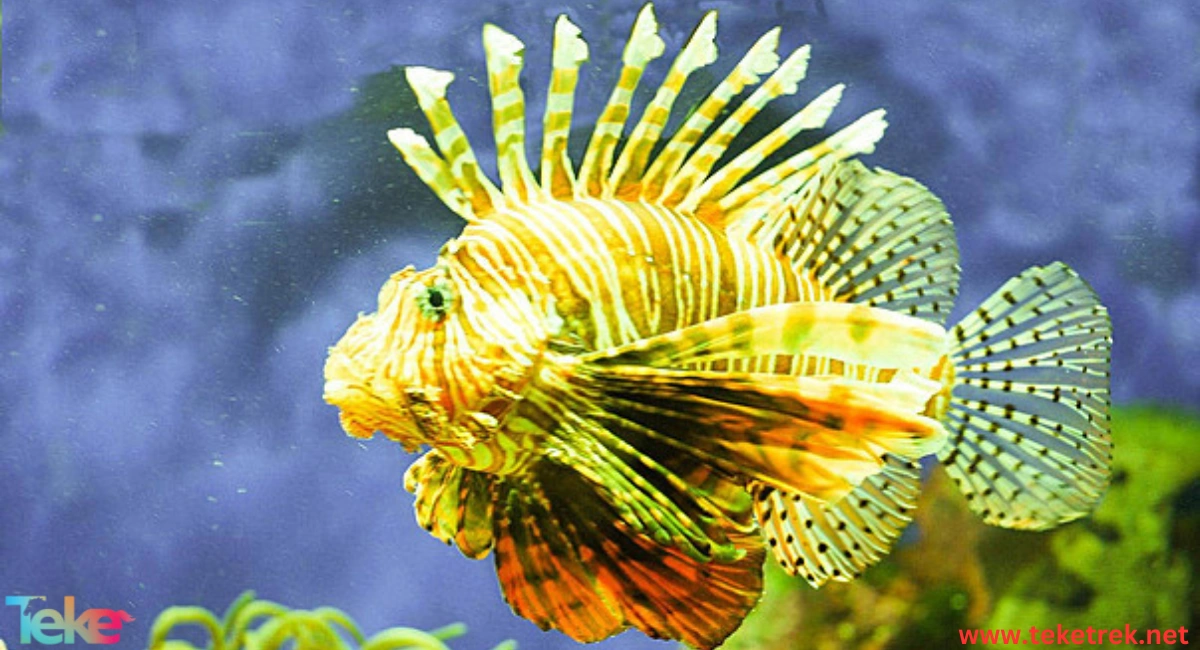In the vast expanse of the Eastern Atlantic Ocean, the scorpion fish stand out as a symbol of resilience and adaptability. Their complex shape, ecological importance, and subtle behavioral nuances paint a vivid picture of species intricately woven into the fabric of marine life.
Learn more about these fish in this article on TekeTrek.

External Appearance of Scorpionfish
- The scorpionfish, also known as “sea scorpions,” are small, unsightly marine fish ranging from 5 to 45 cm in length. They are called sea scorpions because they resemble the frightening shape of a scorpion.
- Scorpionfish belong to the phylum Chordata, subphylum Vertebrata, and class Actinopterygii.
- There are poisonous spines on the dorsal fin of the scorpionfish, and the venom is in bulbous venom glands located near the base of the poisonous spine in the dorsal fin.
- Scorpionfish are renowned for their mastery of camouflage, displaying a remarkable variety of colors specially designed for their specific habitats. The colors of scorpionfish range from bright red shades to mottled brown and gray, reflecting the texture and patterns of their surrounding environment with astonishing accuracy.
Habitats of Scorpionfish
Scorpionfish primarily live in the waters of the Mediterranean region. However, their presence extends to the Eastern Atlantic Ocean, albeit in limited numbers. Additionally, their range includes diverse areas such as Senegal, the Canary Islands, and Cape Verde in the southern regions of the Eastern Atlantic Ocean.
The geographical distribution of scorpionfish in the Eastern Atlantic is remarkably extensive, stretching from the British Isles, where there is still a scattered presence, to southern areas like Senegal, and westward to the Canary Islands and Cape Verde.
The preferred habitats of scorpionfish include a range of substrates, including rocky, sandy, or muddy bottoms, often adorned with dense marine vegetation.
Diet of Scorpionfish
- The scorpionfish in the Eastern Atlantic, expertly camouflaged and skilled in disguise, are predatory animals that ambush their prey within their underwater range. Their hunting strategy relies on patience and stealth, seamlessly blending into the rocky seabed and patiently waiting for unsuspecting prey to approach.
- Small fish, crustaceans, and mollusks are among their preferred targets, which they skillfully hunt. When the moment arrives, these predators unleash lightning-fast strikes, using their large, expandable mouths to swallow their victims quickly and decisively.
Lifestyle of Scorpionfish
- During daylight hours, scorpionfish adopt a solitary lifestyle, seeking refuge within caves or other protected locations. As dusk falls and darkness envelops the underwater world, this mysterious creature emerges from its hiding places to engage in nocturnal hunting activities. This behavior highlights the species’ remarkable adaptability and illustrates its ability to navigate the contrasting rhythms of day and night life beneath the waves.
- Scorpionfish in the Eastern Atlantic live in diverse marine environments alongside countless other fish species. The skilled camouflage of scorpionfish enables them to coexist harmoniously with non-predatory fish, seamlessly blending into their surroundings without posing any threat. However, the poisonous spines of scorpionfish serve as an effective defense mechanism against potential predators, preventing larger fish species from preying on them.
- Interestingly, in some cases, small fish may find refuge and protection near scorpionfish, using them as shelter from predators. This complex interaction between scorpionfish and neighboring fish communities underscores the dynamic nature of marine ecosystems and the intricate relationships that shape their ecological dynamics.
Predators of Scorpionfish
Despite their formidable venomous defenses, scorpionfish remain vulnerable to predation by larger marine creatures. Among the primary predators are large fish species such as groupers, sharks, and stingrays, which possess the strength and agility to overcome the defenses of scorpionfish.
Reproduction of Scorpionfish
- In the world of scorpionfish, the female reigns as the queen of the coral reefs. These majestic creatures can grow up to 30 cm in length and are adorned with vibrant colors that attract potential partners. Female scorpionfish in the Eastern Atlantic exhibit fierce territorial instincts, vigorously defending their domain and fiercely protecting their young from potential threats.
- The reproductive journey of scorpionfish begins with the formation of eggs that appear as transparent celestial bodies. Despite their small size, these eggs possess a remarkable ability to camouflage themselves, seamlessly blending into their aquatic surroundings and evading the eyes of potential predators. The development period spans several days, a process intricately affected by factors such as water temperature, gradually transforming from tiny embryos into fully formed young, ready to begin their journey of survival and growth.
- Upon hatching, a new generation of scorpionfish begins in the Eastern Atlantic. The fry are mere millimeters in length, and their transparent bodies provide a cloak of invisibility against the backdrop of the ocean depths.
- The fry instinctively harmonizes with their surroundings, drifting with gentle currents and navigating the vast expanse of the sea with remarkable agility.
- When European goldfinches mature, they undergo a transformative journey, gradually acquiring the skills and adaptations necessary to thrive in their habitat. Ultimately, they settle on coral reefs, joining the ranks of their elders as vital contributors to the complex underwater ecosystem.
- As for the question of whether European goldfinches are edible, it’s worth noting that while certain species of scorpionfish are already harvested for consumption, especially in regions where they are considered a delicacy, the Eastern Atlantic varieties are generally not targeted for commercial fishing. This is primarily due to their relatively small size and the presence of venomous spines, which makes them less attractive compared to other commercially valuable fish species.
Common questions about scorpionfish
- How poisonous are scorpionfish?
When the body of a scorpionfish comes into contact with any living organism, whether another fish or a human, its spines release a toxic substance. These spines often break off in the victim’s body, causing intense pain. Additionally, the affected area may swell, become numb, and the venom can lead to severe nausea, vomiting, and difficulty breathing. In extreme cases, delayed medical attention could even result in death.
- What Is the Lifespan of Scorpionfish?
Scorpionfish are classified as long-lived organisms, with estimated lifespans typically ranging from 10 to 20 years
- What does a scorpion fish look like?
Scorpionfish are covered in feathery fins or skin flaps that help with camouflage against surrounding coral.


In conclusion, scorpionfish are caught throughout their range using hooks, lines, traps, or gill nets in shallow waters. Their fresh flesh is marketed for human consumption. However, it’s important to note that this type of fish can be venomous at times due to the presence of dorsal spines that release venom upon penetration. So, caution is advised when handling or consuming scorpionfish.






